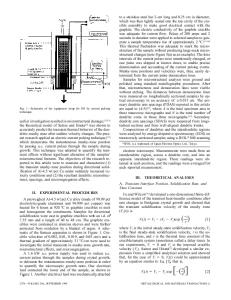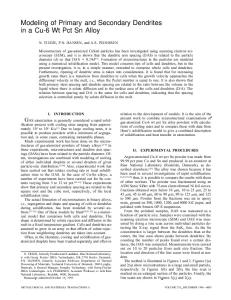Nature of dislocation sub-boundaries formed during creep of Cu 6 Wt Pct Al crystals oriented for co-planar slip
- PDF / 1,410,732 Bytes
- 3 Pages / 613 x 788.28 pts Page_size
- 20 Downloads / 285 Views
;.-:'-.-=-:-
:-27)-.;:
D. L. KLARSTROM, R. A. DODD, AND P. R. STRUTT The requirements for the formation of stable subgrain boundaries resulting from the interaction of dislocations of two glide systems have been considered by Amelinckx 1 and Amelinckx and Dekeyser.a Kear utilized these formulae to postulate specific sub-bound= a r y types that might be produced in fcc crystals oriented for multiple slip. s Accordingly, crystals with s t r e s s axes parallel to [001], [111], [101], [112], [102] and [212] would be expected to work harden in a prog r e s s i v e l y weaker manner, based on the types and s t r e s s stabilities of the sub=boundaries that can form. The prediction that the first four orientations above would favor the development of Lomer-Cottrell sessile tilt boundaries is of special significance. It is expected that these sub-boundaries would become permanent sub= structural features in the form Of diffuse deformation bands instead of well defined dislocation walls, and under special circumstances perhaps grow to macro= scopic size. In the present study, alpha Cu 6 wt pct A1 single c r y s tals were grown by the Bridgman method from oriented seed crystals to have an orientation 10 deg from [111] on the s y m m e t r y line between [111] and [101]. In t e r m s of the p r i m a r y glide systems, [011] ( l i l ) and [110] (111), this orientation resembles [212] and it would not be expected to give rise to strong work hardening. From the analysis of Kear, s deformation bands are expected to form in (110) with a rotation axis along [1i2]. In the present experiments, the compositions of all crystals used were within • wt pct A1 of the nominal 6 wt pct A1, the initial dislocation densities were 106 cm -a, and the mean sub=grain diam was 2.5 x 10-2 cm. Creep tests were conducted under constant load in an argon-5 pct hydrogen atmosphere, after which the crystals were cut parallel to {111} planes by electrical discharge machining. The cut surfaces were planed electrochemically to develop smooth damagefree flats, and sub-boundary structures were produced using a modification of Livingston's dislocation etch-pit reagent for copper. 4 The alignments observed on several {111} sections were used to define boundary contact planes as well as to envision the three-dimensional nature of the sub-boundary structure. Crystals strained well into secondary creep at 750~ and under resolved shear s t r e s s e s of 0.23, 0.34 and
(b)
(c) D. L. KLARSTROM is Research Metallurgist, Cabot Corporation, Kokomo, Ind. 46901. R. A. DODD, Member AIME, is Professor of Metallurgy, University of Wisconsin, Madison, Wis. 53706. P. R. STRUTT, Member AIME, is Associate Professor of Metallurgy, University of Connecticut, Storrs, Conn. 06268. Manuscript submitted November 10, 1972. METALLURGICAL TRANSACTIONS
Fig. 1--Etch pit structures on {111} planes of Cu 6 wt pct A1 single crystal oriented 10 deg from [111] on the [111]-[101] s y m m e t r y line, after steady state creep. Magnification 675 times. (a) t = 2 h , T = 750~C, r = 5 0 0 g
Data Loading...











